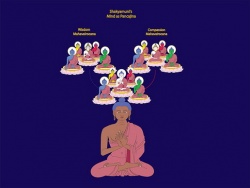The Stream of Consciousness
by William James
The first and foremost concrete fact which every one will affirm to belong to our inner experience is the fact that consciousness of some sort goes on. “States of mind” succeed each other in us. If we could say in English “it thinks,” as we say “it rains” or “it blows,” we should be stating the fact most simply and with the minimum of assumption. As we cannot, we must simply say that thought goes on.
How does it go on? We notice immediately four important characters in the process, of which it shall be the duty of the present chapter to treat in a general way: 1) Every “state” tends to be part of a personal consciousness. 2) Within each personal consciousness states are always changing. 3) Each personal consciousness is sensibly continuous. 4) It is interested in some parts of its object to the exclusion of others, and welcomes or rejects—chooses from among them, in a word—all the while.
In this room—this lecture-room, say— there are a multitude of thoughts, yours and mine, some of which cohere mutually, and some not. They are as little each-for-itself and reciprocally independent as they are all-belonging-together. They are neither: no one of them is separate, but each belongs with certain others and with none beside. My thought belongs with my other thoughts, and your thought with your other thoughts. Whether anywhere in the room there be a mere thought, which is nobody’s thought, we have no means of ascertaining, for we have no experience of its like. The only states of consciousness that we naturally deal with are found in personal consciousness, minds, selves, concrete particular I’s and you’s.
Each of these minds keeps its own thought to itself. There is no giving or bartering between them. No thought even comes into direct sight of a thought in another personal consciousness than its own. Absolute insulation, irreducible pluralism, is the law. It seems as if the elementary psychic fact were not thought or this thought or that thought, but my thought, every thought being owned. Neither contemporaneity, nor proximity in space, nor similarity of quality and content are able to fuse thoughts together which are sundered by this barrier of belonging to different personal minds. The breaches between such thoughts are the most absolute breaches in nature. Every one will recognize this to be true, so long as the existence of something corresponding to the term “personal mind” is all that is insisted on, without any particular view of its nature being implied. On these terms the personal self rather than the thought might be treated as the immediate datum in psychology. The universal conscious fact is not “feelings and thoughts exist,” but “I think” and “I feel.” No psychology, at any rate, can question the existence of personal selves. Thoughts connected as we feel them to be connected are what we mean by personal selves. The worst a psychology can do is so to interpret the nature of these selves as to rob them of their worth.
Consciousness is in constant change. I do not mean by this to say that no one state of mind has any duration—even if true, that would be hard to establish. What I wish to lay stress on is this, that no state once gone can recur and be identical with what it was before. Now we are seeing, now hearing; now reasoning, now willing; now recollecting, now expecting; now loving, now hating; and in a hundred other ways we know our minds to be alternately engaged. But all these are complex states, it may be said, produced by combination of simpler ones—do not the simpler ones follow a different law? Are not the sensations which we get from the same object, for example, always the same? Does not the same piano-key, struck with the same force, make us hear in the same way? Does not the same grass give us the same feeling of green, the same sky the same feeling of blue, and do we not get the same olfactory sensation no matter how many times we put our nose to the same flask of cologne? It seems a piece of metaphysical sophistry to suggest that we do not; and yet a close attention to the matter shows that there is no proof that an incoming current ever gives us just the same bodily sensation twice.
What is got twice is the same object. We hear the same note over and over again; we see the same quality of green, or smell the same objective perfume, or experience the same species of pain. The realities, concrete and abstract, physical and ideal, whose permanent existence we believe in, seem to be constantly coming up again before our thought, and lead us, in our carelessness, to suppose that our “ideas” of them are the same ideas. Later, we shall see how inveterate is our habit of simply using our sensible impressions as stepping-stones to pass over to the recognition of the realities whose presence they reveal. The grass out of the window now looks to me of the same green in the sun as in the shade, and yet a painter would have to paint one part of it dark brown, another part bright yellow, to give its real sensational effect. We take no heed, as a rule, of the different way in which the same things look and sound and smell at different distances and under different circumstances. The sameness of the things is what we are concerned to ascertain; and any sensations that assure us of that will probably be considered in a rough way to be the same with each other. This is what makes off-hand testimony about the subjective identity of different sensations well-nigh worthless as a proof of the fact. The entire history of what is called Sensation is a commentary on our inability to tell whether two sensible qualities received apart are exactly alike. What appeals to our attention far more than the absolute quality of an impression is its ratio to whatever other impressions we may have at the same time. When everything is dark a somewhat less dark sensation makes us see an object white. Helmholtz calculates that the white marble painted in a picture representing an architectural view by moonlight is, when seen by daylight, from ten to twenty thousand times brighter than the real moonlit marble would be.
Such a difference as this could never have been sensibly learned; it had to be inferred from a series of indirect considerations. These make us believe that our sensibility is altering all the time, so that the same object cannot easily give us the same sensation over again. We feel things differently accordingly as we are sleepy or awake, hungry or full, fresh or tired; differently at night and in the morning, differently in summer and in winter; and above all, differently in childhood, adulthood, and old age. And yet we never doubt that our feelings reveal the same world, with the same sensible qualities and the same sensible things occupying it. The difference of the sensibility is shown best by the difference of our emotion about the things from one age to another, or when we are in different organic moods. What was bright and exciting becomes weary, flat, and unprofitable. The bird’s song is tedious, the breeze is mournful, the sky is sad.
To these indirect presumptions that our sensations, following the mutations of our capacity for feeling, are always undergoing an essential change, must be added another presumption, based on what must happen in the brain. Every sensation corresponds to some cerebral action. For an identical sensation to recur it would have to occur the second time in an unmodified brain. But as this, strictly speaking, is a physiological impossibility, so is an unmodified feeling an impossibility; for to every brain-modification, however small, we suppose that there must correspond a change of equal amount in the consciousness which the brain subserves.
But if the assumption of “simple sensations” recurring in immutable shape is so easily shown to be baseless, how much more baseless is the assumption of immutability in the larger masses of our thought!
For there it is obvious and palpable that our state of mind is never precisely the same. Every thought we have of a given fact is, strictly speaking, unique, and only bears a resemblance of kind with our other thoughts of the same fact. When the identical fact recurs, we must thing of it in a fresh manner, see it under a somewhat different angle, apprehend it in different relations from those in which it last appeared. And the thought by which we cognize it is the thought of it-in-those-relations, a thought suffused with the consciousness of all that dim context. Often we are ourselves stuck at the strange differences in our successive views of the same thing. We wonder how we ever could have opined as we did last month about a certain matter. We have outgrown the possibility of that state of mind, we know not how. From one year to another we see things in new lights. What was unreal has grown real, and what was exciting is insipid. The friends we used to care the world for are shrunken to shadows; the women once so divine, the stars, the woods, and the waters, how now so dull and common!—the young girls that brought an aura of infinity, at present hardly distinguishable existences; the pictures so empty; and as for the books, what was there to find so mysteriously significant in Goethe, or in John Mill so full of weight? Instead of all this, more zestful than ever is the work, the work; and fuller and deeper the import of common duties and of common goods.
I am sure that this concrete and total manner of regarding the mind’s changes is the only true manner, difficult as it may be to carry it out in detail. If anything seems obscure about it, it will grow clearer as we advance. Meanwhile, if it be true, it is certainly also true that no two “ideas” are ever exactly the same, which is the proposition we started to prove. The proposition is more important theoretically than it at first sight seems. For it makes it already impossible for us to follow obediently in the footprints of either the Lockian or the Herbartian school, schools which have had almost unlimited influence in Germany among ourselves. No doubt it is often convenient to formulate the mental facts in an atomistic sort of way, and to treat the higher states of consciousness as if they were all built out of unchanging simple ideas which “pass and turn again.” It is convenient often to treat curves as if they were composed of small straight lines, and electricity and nerve-force as if they were fluids. But in the one case as in the other we must never forget that we are talking symbolically, and that there is nothing in nature to answer to our words. A permanently existing “Idea” which makes its appearance before the footlights of consciousness at periodical intervals is as mythological an entity as the Jack of Spades.
Within each personal consciousness, thought is sensibly continuous. I can only define “continuous” as that which is without breach, crack, or division. The only breaches that can well be conceived to occur within the limits of a single mind would either be interruptions, time-gaps during which the consciousness went out; or they would be breaks in the content of the thought, so abrupt that what followed had no connection whatever with what went before. The proposition that consciousness feels continuous, means two things:
a. That even where there is a time-gap the consciousness after it feels as if it belonged together with the consciousness before it, as another part of the same self;
b. That the changes from one moment to another in the quality of the consciousness are never absolutely abrupt.
The case of the time-gaps, as the simplest, shall be taken first.
When Paul and Peter wake up in the same bed, and recognize that they have been asleep, each one of them mentally reaches back and makes connection with but one of the two streams of thought which were broken by the sleeping hours. As the current of an electrode buried in the ground unerringly finds its way to its own similarly buried mate, across no matter how much intervening earth; so Peter’s present instantly finds out Peter’s past, and never by mistake knits itself on to that of Paul. Paul’s thought in turn is as little liable to go astray. The past thought of Peter is appropriated by the present Peter alone. He may have a knowledge, and a correct one too, of what Paul’s last drowsy states of mind were as he sank into sleep, but it is an entirely different sort of knowledge from that which he has of his own last states. He remembers his own states, whilst he only conceives Paul’s. Remembrance is like direct feeling; its object is suffused with a warmth and intimacy to which no object of mere conception ever attains. This quality of warmth and intimacy and immediacy is what Peter’s present thought also possesses for itself. So sure as this present is me, is mine, it says, so sure is anything else that comes with the same warmth and intimacy and immediacy, me and mine. What the qualities called warmth and intimacy may in themselves be will have to be a matter for future consideration. But whatever past states appear with those qualities must be admitted to receive the greeting of the present mental state, to be owned by it, and accepted as belonging together with it in a common self. This community of self is what the time-gap cannot break in twain, and is why a present thought, although not ignorant of the time-gap, can still regard itself as continuous with certain chosen portions of the past.
Consciousness, then, does not appear to itself chopped up in bits. Such words as “chain” or “train” do not describe it fitly as it presents itself in the first instance. It is nothing jointed; it flows. A “river” or a “stream” are the metaphors by which it is most naturally described. In talking of it hereafter, let us call it the stream of thought, of consciousness, or of subjective life.
But now there appears, even within the limits of the same self, and between thoughts all of which alike have this same sense of belonging together, a kind of jointing and separateness among the parts, of which this statement seems to take no account. I refer to the breaks that are produced by sudden contrasts in the quality of the successive segments of the stream of thought. If the words “chain” and “train” had no natural fitness in them, how came such words to be used at all? Does not a loud explosion rend the consciousness upon which it abruptly breaks, in twain? No; for even into our awareness of the thunder the awareness of the previous silence creeps and continues; for what we hear when the thunder crashes is not thunder pure, but thunder-breaking-upon-silence-and-contrasting-with-it. Our feeling of the same objective thunder, coming in this way, is quite different from what it would be were the thunder a continuation of previous thunder. The thunder itself we believe to abolish and exclude the silence; but the feeling of the thunder is also a feeling of the silence as just gone; and it would be difficult to find in the actual concrete consciousness or person a feeling so limited to the present as not to have an inkling of anything that went before.
Consciousness is always interested more in one part of its object than in another, and welcomes and rejects, or chooses, all the while it thinks.
The phenomena of selective attention and of deliberative will are of course patent examples of this choosing activity. But few of us are aware how incessantly it is at work in operations not ordinarily called by these names. Accentuation and Emphasis are present in every perception we have. We find it quite impossible to disperse our attention impartially over a number of impressions. A monotonous succession of sonorous strokes is broken up into rhythms, now of one sort, now of another, by the different accent which we place on different strokes. The simplest of these rhythms is the double one, tick-tock, tick-tock, tick-tock. Dots dispersed on a surface are perceived in rows and groups. Lines separate into diverse figures. The ubiquity of the distinctions, this and that, here and there, now and then, in our minds is the result of our laying the same selective emphasis on parts of place and time.
But we do far more than emphasize things, and unite some, and keep others apart. We actually ignore most of the things before us. Let me briefly show how this goes on.
To begin at the bottom what are our very senses themselves but organs of selection? Out of the infinite chaos of movements, of which physics teaches us that the outer world consists, each sense-organ picks out those which fall within certain limits of velocity. To these it responds, but ignores the rest as completely as if they did not exist. Out of what is in itself an undistinguishable swarming continuum, devoid of distinction or emphasis, our senses make for us, by attending to this motion and ignoring that, a world full of contrasts, of sharp accents, of abrupt changes, of picturesque light and shade.
If the sensations we receive from a given organ have their causes thus picked out for us by the conformation of the organ’s termination, Attention, on the other hand, out of all the sensations yielded, picks out certain ones as worthy of notice and suppresses all the rest. We notice only those sensations which are signs to us of things which happen practically or aesthetically to interest us, to which we therefore give substantive names, and which we exalt to this exclusive status of independence and dignity. But in itself, apart from my interest, a particular dust-wreath on a windy day is just as much of an individual thing, and just as much or as little deserves an individual name, as my own body does.
And then, among the sensations we get from each separate thing, what happens? The mind selects again. It chooses certain of the sensations to represent the thing most truly, and considers the rest as its appearances, modified by the conditions of the moment. Thus my table-top is named square, after but one of an infinite number of retinal sensations which it yields, the rest of them being sensations of two acute and two obtuse angles; but I call the latter perspective views, and the four right angles the true form of the table, and erect the attribute squareness into the table’s essence, for aesthetic reasons of my own. In like manner the real form of the circle is deemed to be the sensation it gives when the line of vision is perpendicular to its centre—all its other sensations are signs of this sensation. The real sound of the cannon is the sensation it makes when the ear is close by. The real color of the brick is the sensation it gives when the eye looks squarely at it from a near point, out of the sunshine and yet not in the gloom; under other circumstances it gives us other color-sensations which are but signs of this—we then see it looks pinker or bluer than it really is. The reader knows no object which she does not represent to herself by preference as in some typical attitude, of some normal size, at some characteristic distance, of some standard tint, etc., etc. But all these essential characteristics, which together form for us the genuine objectivity of the thing and are contrasted with what we call the subjective sensations it may yield us at a given moment, are mere sensations like the latter. The mind chooses to suit itself, and decides what particular sensation shall be held more real and valid than all the rest.
Now, in a world of objects thus individualized by our mind’s selective industry, what is called our “experience” is almost entirely determined by our habits of attention. A thing may be present to a person a hundred times, but if one persistently fails to notice it, it cannot be said to enter one’s experience. We are all seeing flies, moths, and beetles by the thousand, but to whom, save an entomologist, do they say anything distinct? On the other hand, a thing met only once in a lifetime may leave an indelible experience in the memory. Let four people make a tour in Europe. One will bring home only picturesque impressions—costumes and colors, parks and views and works of architecture, pictures and statues. To another all this will be non-existent; and distances and prices, populations and drainage-arrangements, door and window fastenings, and other useful statistics will take their place. A third will give a rich account of the theaters, restaurants, and public halls, and naught besides; while the fourth will perhaps have been so wrapped in his own subjective broodings as to be able to tell little more than a few names of places through which he passed. Each has selected, out of the same mass of presented objects, those which suited their private interest and has made their experience thereby.
If now, leaving the empirical combination of objects, we ask how the mind proceeds rationally to connect them, we find selection again to be omnipotent. All Reasoning depends on the ability of the mind to break up the totality of the phenomenon reasoned about, into parts, and to pick out from among these the particular one which, in the given emergency, may lead to the proper conclusion. The genius is one who will always stick in a bill at the right point, and bring it out with the right element—“reason” if the emergency be theoretical, “means” if it be practical—transfixed upon it.
If now we pass to the aesthetic department, our law is still more obvious. The artist notoriously selects her items, rejecting all tones, colors, shapes, which do not harmonize with each other and with the main purpose of her work. That unity, harmony, “convergence of character,” as M. Taine calls it, which gives to works of art their superiority over works of nature, is wholly due to elimination. Any natural subject will do, if the artist has wit enough to pounce upon some one feature of it as characteristic, and suppress all merely accidental items which do not harmonize with this.
Ascending still higher, we reach the plane of Ethics, where choice reigns notoriously supreme. An act has no ethical quality whatever unless it be chosen out of several all equally possible. To sustain the arguments for the good course and keep them ever before us, to stifle our longing for more flowery ways, to keep the foot unflinchingly on the arduous path, these are characteristic ethical energies. But more than these; for these but deal with the means of compassing interests already felt by us to be supreme. The ethical energy par excellence has to go farther and choose which interest out of several, equally coercive, shall become supreme. The issue here is of the utmost pregnancy, for it decides a person’s entire career. When we debate, Shall I commit this crime? Choose that profession? Accept that office, or marry this fortune? —our choice really lies between one of several equally possible future Characters. What we shall become is fixed by the conduct of this moment. Schopenhauer, who enforces his determinism by the argument that with a given fixed character only one reaction is possible under given circumstances, forgets that, in these critical ethical moments, what consciously seems to be in question is the complexion of the character itself. The problem with us is less what act we shall now resolve to do than what being we shall now choose to become.
Taking human experience in a general way, the choosings of different people are to a great extent the same. The race as a whole largely agrees as to what it shall notice and name; and among the noticed parts we select in much the same way for accentuation and preference, or subordination and dislike. There is, however, one entirely extraordinary case in which no two people ever are known to choose alike. One great splitting of the whole universe into two halves is made by each of us; and for each of us almost all of the interest attaches to one of the halves; but we all draw the line of division between them in a different place. When I say that we all call the two halves by the same names, and that those names are “me” and “not-me” respectively, it will at once be seen what I mean. The altogether unique kind of interest which each human mind feels in those parts of creation which it can call me or mine may be a moral riddle, but it is a fundamental psychological fact. No mind can take the same interest in one’s neighbor’s me as in one’s own. The neighbor’s me falls together with all the rest of things in one foreign mass against which one’s own me stands cut in startling relief. Even the trodden worm, as Lotze somewhere says, contrasts its own suffering self with the whole remaining universe, though it has no clear conception either of itself or of what the universe may be. It is for me a mere part of the world; for it, it is I who am the mere part. Each of us dichotomizes the Kosmos in a different place.
William James was one of the founding fathers of contemporary psychology and an influential thinker in the domains of religion, philosophy and morality. His most famous works include Principles of Psychology, The Will to Believe, Human Immortality and The Varieties of Religious Experience.









